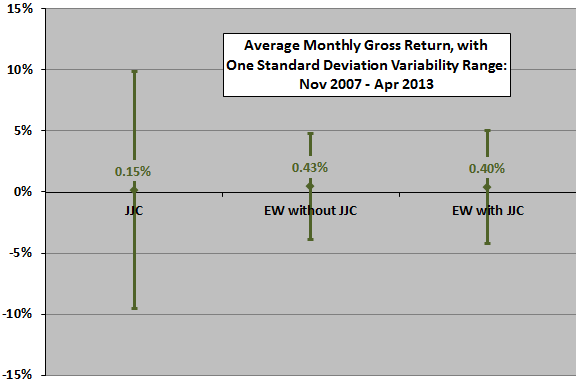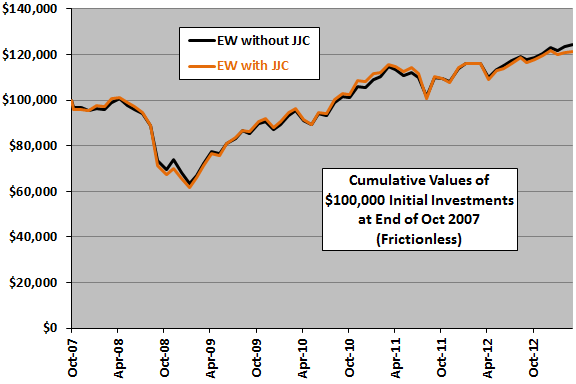A subscriber suggested testing the diversification power of iPath DJ-UBS Copper ETN (JJC) as a distinct asset class. To check, we add JJC to the following mix of asset class proxies (the same used in “Simple Asset Class ETF Momentum Strategy”):
PowerShares DB Commodity Index Tracking (DBC)
iShares MSCI Emerging Markets Index (EEM)
iShares MSCI EAFE Index (EFA)
SPDR Gold Shares (GLD)
iShares Russell 1000 Index (IWB)
iShares Russell 2000 Index (IWM)
SPDR Dow Jones REIT (RWR)
iShares Barclays 20+ Year Treasury Bond (TLT)
3-month Treasury bills (Cash)
First, per the findings of “Asset Class Diversification Effectiveness Factors”, we measure the average monthly return for JJC and the average pairwise correlation of JJC monthly returns with the monthly returns of the above assets. Then, we compare cumulative returns and basic monthly return statistics for equally weighted (EW), monthly rebalanced portfolios with and without JJC. We ignore rebalancing frictions, which would be about the same for the alternative portfolios. Using adjusted monthly returns for JJC and the above nine asset class proxies from November 2007 (first return available for JJC) through April 2013 (66 monthly returns), we find that:
The following chart summarizes average monthly returns with variability ranges of one standard deviation for JJC and the EW portfolios without and with JJC over the available sample period. During this time, JJC generates a good average return but with high volatility. Adding JJC to the diversified EW portfolio barely affects average monthly return and modestly increases volatility. The ratio of average return to standard deviation (return per unit of risk) is 0.10 (0.09) without (with) a JJC position.
The average pairwise correlation of JJC monthly returns with those of the other assets is a moderate 0.39 over the available sample period. Fairly high correlations with DBC, EEM and other equity funds drive this result.
Per “Asset Class Diversification Effectiveness Factors,” the modest average return (moderate average pairwise correlation) of JJC indicates a modest (middling) contribution with respect to portfolio diversification.
Sample size is not large in terms of number of months, and especially, variety of market conditions.
What is the net effect on cumulative portfolio performance?

The next chart compares cumulative values of EW portfolios without and with JJC in the mix over the available sample period. There is very little difference between the two trajectories.
Again, sample size is not large.

In summary, evidence from simple tests over the available sample period offers little support for a belief that adding a proxy for copper as a distinct asset class to a diversified portfolio improves overall performance.
Cautions regarding findings include:
- As noted, the sample period is very short in terms of market conditions (one bear market and part of one bull market).
- Including the trading frictions associated with monthly rebalancing would depress performance of both portfolios, depending mostly on portfolio size. When a portfolio of X assets performs just as well as one with X+1 assets on a gross basis, the former may be superior on a net basis.